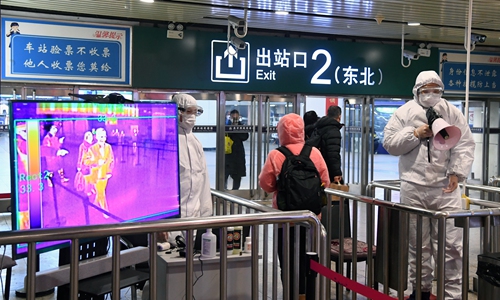HOME >> OPINION
Response to virus shows strength of Party system
By Li Qingqing Source:Global Times Published: 2020/2/3 20:53:40

Staff members check passengers' temperature at the exit of Beijing West Railway Station in Beijing, capital of China, Jan. 28, 2020. (Xinhua/Ren Chao)
Many foreigners and Western media are not familiar with the operations of China's primary-level Party organizations. This is a chance for the outside world to observe the Chinese system. The epidemic is still spreading and the situation is still very grim. To really prevent and control the epidemic, we need to focus on every community and household. In this process, primary-level Party organizations can play an essential role. Whether we can resist the attack of the epidemic to a large extent depends on the work of these organizations.
By the end of 2018, the total number of CPC membership was more than 90 million and primary-level Party organizations rose to 4.61 million. These organizations will together form great power when they are fully mobilized. China is fighting the epidemic, and in this process, primary-level Party organizations have quickly joined the frontline battle.
Indeed, these organizations are facing great pressure. For example, since the outbreak of the epidemic, most hospitals in Wuhan have been overcrowded. Many people who did not have obvious symptoms would have to be observed at home. This had added much pressure to Wuhan's primary-level Party organizations. But due to the strengthening of the building of primary-level Party branches in recent years, the process of fighting the epidemic has been generally in order among local Chinese communities.
China's primary-level Party organizations, especially those in key areas such as Wuhan, have been mobilized. They have formed an effective network to fight the epidemic. For instance, people who come out of the city of Wuhan after the outbreak can be quickly traced and located. These organizations have adopted quite strict quarantine measures to block the input of infectious patients, reducing the risk of local epidemic transmission.
The primary-level Party organizations have also been working to publicize the situation of the epidemic. In North China's Inner Mongolia Autonomous Region, the primary-level Party organizations have made many Putonghua-Mongolian bilingual short videos to introduce people ways to prevent the spread of the epidemic.
It is not yet time to say exactly what role primary-level Party organizations have played in the current fight against the epidemic. However, this may be a good chance for some foreigners and foreign media to learn more about China. As China is fighting the epidemic, some Western media are badmouthing and blackening the Chinese system. We hope that they can see the efficient operations of China's primary-level Party organizations. This will help them understand China more objectively and comprehensively.
Posted in: OBSERVER